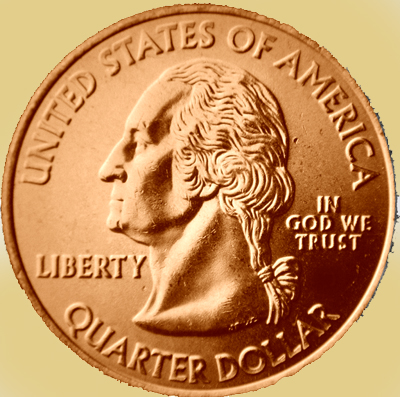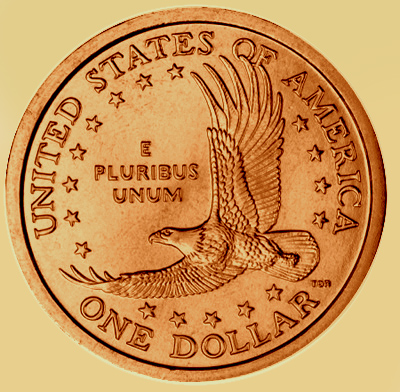PART III. Die Installation Errors:
Mules:
Two Different Denominations


Debuting in May of 2000, this slip up was destined to make history. At the time, it was the only known “mule” coin in United States history.
For those who are not professional numismatists, a mule is a pairing of two different coin designs on one coin — in this case, a State Quarter and the brand new Sacagawea dollar. Previous to the discovery specimen of this famous coin, mules were not known to exist in United States coinage, though commonly found in foreign series.
After authentication and subsequent confirmation of its existence by the United States Mint, a firestorm of controversy was set off. How could this happen? Was it intentional? The biggest debate — was it legal to own?
After near forensic inspection and an unconfirmed report by an anonymous US Mint employee, it was determined that the anomaly was produced due to the similar sizes of the “coin dies” of a State Quarter and the new Sacagawea dollar. A coin die is the part of a coin press that places the design on the coin. Ironically, this was the very reason that the previous dollar coin, the Susan B Anthony, was despised by the public.
The quarter die was placed into a press currently in production of Sacagawea dollars. The rest is history — several coins were struck before the error was discovered. Many of the coins were discovered before reaching the public and were subsequently destroyed.
Interestingly, upon closer inspection of the 10 known specimens, it’s apparent that the errors were produced at three separate times. It’s theorized that these are “copycat” errors produced by rogue US Mint employees after word spread of the first discovery. Many of the coins were discovered in Philadelphia, the home of the primary United States Mint.
While it’s been nearly a decade since the last sale of the Sacagawea Mule, it’s speculated that they could bring a whopping $250,000 at auction. 8 of the 10 known specimens have been handled by the author, Fred Weinberg of Beverly Hills.
There are now ten (10) confirmed specimens of the Sacagawea Dollar/Quarter Mule. The ten confirmed specimens
are:
Mule #1. The “Discovery” specimen, found in Mountain Home, Arkansas by Frank Wallis. Originally sold by Bowers & Merena Auction Galleries at the 2000 ANA Philadelphia Millennium Sale for $29,900. Purchased from Dwight Manley by Fred Weinberg in late June 2001 and then sold to Tommy Bolack for $67,000. PCGS MS-66 (Die Pair #1)
Mule #2. The “eBay” specimen, sold by Delaware Valley Rare Coin Co., in Bromall Pennsylvania for $41,395 in July 2000. Purchased at the Heritage Numismatic Auctions Signature Sale held June 1, 2001 at the Long Beach Coin Expo for a then record price of $56,350, by Tommy Bolack. NGC MS-67 (Die Pair #2)
Mule #3. The “Heritage Auction” specimen, sold in the Heritage Numismatic Auction Pre-ANA Sale August 6, 2000 for $31,050. Then into a private collection, after being purchased off an eBay Auction in October 2000. Currently owned by Tommy Bolack. NGC MS-66 (Die Pair #2)
Mule #4. The “Margolis” specimen, originally from Fred Weinberg of Encino, CA. Sold by Arnold Margolis to a private collector in September 2000 for $47,500. PCGS MS-65 (Die Pair #1)
Mule #5. The “Greg Senske” specimen, found in Cape Girardeau, Missouri. This coin was discovered Sept. 2000 in change from a cashier at a cafeteria, and was in a 25-coin roll of Sacagawea $1, wrapped in a U.S. Mint designated paper wrapper. This piece is not on the market at this time. NGC MS-67 (Die Pair #3)
Mule #6. The “Fred Weinberg” specimen, discovered on the East Coast in June 2000 and sold by Fred Weinberg at the Long Beach Coin Expo October 5, 2000 for $50,000 to an anonymous collector. Purchased in May 2003 for $75,000 by Tommy Bolack. PCGS MS-66 (Die Pair #1)
Mule #7. The “Philadelphia” specimen, purchased by Tommy Bolack from Maryland Coin Exchange in early February 2001 for $48,000. MCE purchased this piece from the man who discovered it in a roll of dollars in July 2000 in Pennsylvania. NGC MS-64 (Die Pair #2)
Mule #8. The “Tommy Bolack-1” specimen, purchased in June 2001. The purchase price was not disclosed. PCGS MS-66 (Die Pair #1)
Mule #9. The “Tommy Bolack-2” specimen purchased in July 2001. The purchase price was not disclosed. PCGS MS-65 (Die Pair #1)
Mule #10. The “Treasury” specimen, first reported in August 2001 by a convenience store owner who received it in payment in his downtown Philadelphia store in summer 2000. It was taken by Treasury Dept. officials in August 2001 to verify authenticity and to examine the piece at the Philadelphia Mint. It was returned by the Treasury Department in October 2001 and subsequently purchased by Fred Weinberg, who sold it in November 2001 to Tommy Bolack for $70,000.